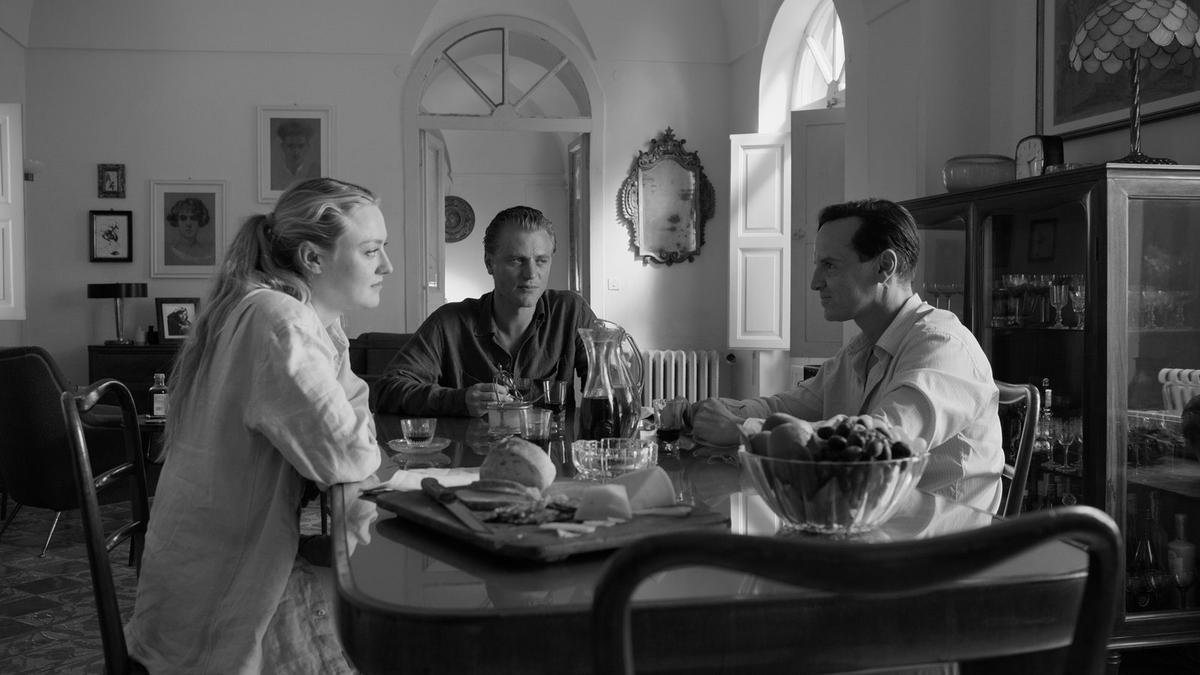
Steven Zaillian’s Ripley is entirely shot in black and white – well not completely, there is one little, teeny, tiny splash of red. This black-and-white palette proves to be an effective distinction from Anthony Minghella’s 1999 film, The Talented Mr. Ripley. Based on Patricia Highsmith’s eponymous 1955 novel about a conman Ripley (Matt Damon), the film was gorgeous and golden.
Ripley
Episodes: 8
Run time: 44 to 76 minutes
Creator: Steven Zaillian
Starring: Andrew Scott, Johnny Flynn, Dakota Fanning, Vittorio Viviani, Bokeem Woodbine, Eliot Sumner
Storyline: A grifter is drawn into a world of wealth and privilege after taking a unique job in Italy. But to seize the life he wants, he must build a web of lies
Featuring stars such as Jude Law, Gwyneth Paltrow, Cate Blanchett, and Philip Seymour Hoffman, the film was a glorious showreel of the swish set in the late 1950s. Those bronze bodies in leisure wear, the excursions on yachts, the art and writing all pointed to the dream life.
Zaillian, who has also written and directed Ripley, said in an interview that the edition of the book he had featured a black-and-white cover (mine has photographs in black-and-white and colour) and he felt it fit the story. While Minghella’s version seemed to suggest there is evil under the sun, a maggot in the reddest of apples (which naturalists will tell you is a good thing), Zaillian chooses the black-and-white route to presage the horrors to come.
In fact, the first sequence in Ripley shows a man dragging a body down the stairs. We are then taken to New York in the 1960s where Tom Ripley (Andrew Scott) living in a grimy apartment, is perpetuating petty cons. When a detective comes looking for him, he first thinks the law has finally caught up with him. The detective, however, was tasked with finding him by a wealthy shipping magnate, Herbert Greenleaf (Kenneth Lonergan).

A still from ‘Ripley’
Greenleaf’s son, Dickie, (Johnny Flynn) is squandering his trust fund traveling in Europe with aspirations to be a writer/artist. Greenleaf, believing Tom knows Dickie, wants him to try and persuade Dickie to return home. Greenleaf promises to take care of Tom’s expenses. Tom looks at the opportunity as heaven sent and sets off to Atrani, on the Amalfi Coast.
Tom meets Dickie (who does not remember him) and his girlfriend Marge Sherwood (Dakota Fanning) who is a writer, and gets a taste of the high life. Like the tiger of legend who gets a taste of human blood, Tom is unwilling to let this golden goose slip out of his hand. He will go to any lengths to keep the pen (that everyone comments is beautiful), the Rolex, the Ferragamo shoes and the Picasso, even if it means murder.
Ripley is full of foreshadowing; the many steps Tom has to climb in Atrani, and later in Rome where the elevator (a veritable thing of beauty) is often not working, is emblematic of Tom’s social climbing. There is also Tom’s shadow falling across Dickie when he first meets him on the beach.
While Dickie owns a Picasso, it is the Italian painter Caravaggio whose works and life runs through Ripley like a vivid, angrily beautiful gash. Caravaggio’s use of chiaroscuro in his works echoes Ripley’s black-and-white palette. The artist was also on the run after committing a murder and Tom follows Caravaggio’s final years as he moved between Naples, Malta, and Sicily. When Tom reaches Venice, he even begins to look like Caravaggio.

A still from ‘Ripley’
Caravaggio’s painting of David and Goliath, which the docent at Vienna explains shows a connection between the victim and his slayer as Caravaggio used his face as a model for both. In the painting, David looks almost tenderly at Goliath. The painting foreshadows Tom in a similar position. And “it is always the light” with Caravaggio. Incidentally, the Canadian intelligence officer in Minghella’s The English Patient is called Caravaggio.
In Zaillian’s Italy, all-seeing sculptures with blind eyes, gracious, ruined columns, stone lions, screaming statues, art, luxury and ruin jostle for their space in the unforgiving, warm sun. If the look, location and sound (operatic jazz) are the pillars on which Zaillian has woven this tale of jealousy, greed and deception, Scott is the high priest of the proceedings.
His performance is the tent-pole, the cornerstone of this edifice of lies. His Ripley, with his predatory smile, that stays too long on his mouth without ever reaching his eyes, is a person one would do well to stay away from. However, he does fix one with his sloe eyes and like a mesmerised rabbit before a snake, we watch him do his nefarious deeds and shamefully, secretly cheer him on.
In the face of such an incandescent performance, others such as Eliot Sumner as the dissipated Freddie Miles and Maurizio Lombardi as Inspector Pietro Ravini investigating the many deaths and disappearance that seem to dog the nice Mr Ripley and John Malkovich as Reeves Minot, an art collector, fade into a background chorus. Ripley is not short on unsettling thrills buttressed by eye-popping locations and a riveting performance.
Ripley is currently streaming on Netflix





